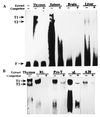A conserved sequence block in murine and human T cell receptor (TCR) Jalpha region is a composite element that enhances TCR alpha enhancer activity and binds multiple nuclear factors
- PMID: 9520454
- PMCID: PMC19924
- DOI: 10.1073/pnas.95.7.3839
A conserved sequence block in murine and human T cell receptor (TCR) Jalpha region is a composite element that enhances TCR alpha enhancer activity and binds multiple nuclear factors
Abstract
A conserved sequence block (CSB) located in a noncoding region of the mouse and human TCR alpha/delta loci, showing six differences over 125 nucleotide positions (95% similar), was subjected to detailed analyses in this study. Transient transfection results showed that the CSB-containing element in conjunction with the TCR alpha enhancer up-regulated the alpha enhancer activity, whereas no enhancer activity was detected when CSB alone was assayed. In vitro occupancy analyses of CSB by nuclear factors reveal the existence of an unexpectedly intricate network of CSB-protein and protein-protein interactions. Lymphoid-specific as well as T-lineage-specific nuclear factors are involved to differentially form CSB-bound complexes in extracts of various tissues and cell lines. Liver was shown to contain factor(s) sequestering thymic CSB-binding factors. Furthermore, the putative binding sites for transcription factors known to be important for lymphoid-lineage development are present in CSB and are targeted by nuclear factors. On the basis of these results, we propose that the CSB element may play a role in shaping the chromatin structure by which the accessibility of TCR alpha/delta loci to the recombinase complex and/or to the transcriptional apparatus can be controlled.
Figures




References
-
- Tonegawa S. Nature (London) 1983;302:575–581. - PubMed
-
- Kronenberg M, Siu G, Hood L, Shastri N. Annu Rev Immunol. 1986;4:529–591. - PubMed
-
- Raulet D H. Annu Rev Immunol. 1989;7:175–207. - PubMed
-
- Honjo T. Annu Rev Immunol. 1983;1:499–528. - PubMed
-
- Yancopoulos G, Blackwell H, Suh H, Hood L, Alt F W. Cell. 1986;44:251–259. - PubMed
Publication types
MeSH terms
Substances
LinkOut - more resources
Full Text Sources
Molecular Biology Databases

